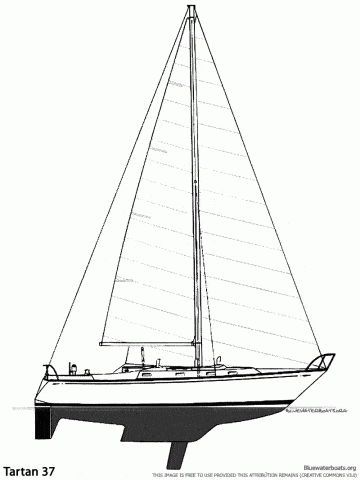
Anyone viewing the pleasingly modern lines of a Tartan 37 would find it hard to believe the first production model hit the market in 1976. Remarkably, Charlie Britton, along with a very talented Sparkman & Stephens design team, effectively incorporated many features important to offshore cruising and racing in a 37-foot hull. The only thing that hints at her age is the trademark plaid-upholstered interior.
Sailing performance and quality construction in an aesthetically pleasing package have been keys to Tartan’s success as a builder. The 37 has been the most popular choice for a variety of practical reasons.
The hull is hand-laid and molded as a single unit. It is cored with end-grain balsa, tapered to solid glass in any high-stress areas (engine bed, mast step, shroud terminals, thru-hulls and keel sections). The deck is of the same construction with excellent molded-in non-skid on all flat surfaces; it is joined to the hull with a bedded, mechanically fastened lap joint that has proven to be strong and dry.
The underbody features a skeg-hung rudder, cutaway forefoot and long fin keel (Tartan did offer the 37 with a deep fin of 6’7″ draft, a Scheel keel of 4’7″ draft, and a centerboard of 4’2″ up, 7’9″ down). Two rigs were offered — a standard rig giving bridge clearance of 52’0″ and a so-called “tall” rig at 53’8″ — supported by standard 1×19 stainless steel wire rigging. With sail area of 625 square feet driving a decidedly efficient hull, the Tartan 37 was capable of competitive racing as well as impressive, comfortable 24-hour runs. As with almost any S&S design, the rudder is efficient and the hull tracks well on all points of sail.
Performance sailing to weather is excellent and the cockpit remains fairly dry, but a good dodger mounted on the molded coaming that surrounds the cockpit and extends just aft of the mid-boom traveler is a must for added shelter. Offwind performance ranks up there with the best of them. Plenty of rudder contributes to great control in full-sail reaching or running situations.
The interior is traditional but larger than you would expect with 11’9″ of beam. It features lots of teak veneer and trim with teak-battened, white Formica overhead. An insert makes the V-berth an acceptable dockside double. The head forward with sink includes a shower spigot; the arrangement is tight but functional. The starboard, main-cabin settee works well as a sea berth, and the port settee converts to a double. The double quarterberth aft is a perk you don’t usually find in a boat this size. A great galley is to starboard and a nav station to port, just at the base of the companionway.
Most 37s are powered by the 32-hp Universal 40, although the Universal 50 was originally offered as an option. Even on the early models, the engine hours tend to be low — a testament to the boat’s sailing abilities. The standard 47-gallon fuel tank provides enough range for coastal or inshore motoring.
The Tartan 37 has held its value well. Early ones (1976-1981) list and sell in the low to mid $50,000 range; newer ones (1982-1988) in the $60,000 to $90,000 range. Price differences relate to condition, equipment or year manufactured. A $50,000 to $60,000 early Tartan 37 with little in the way of equipment (or with electronics still needing an upgrade) represents good value and may even appreciate slightly, depending on treatment given and additional gear added.
When considering buying an older boat, one axiom should be held sacred: Buy a good, capable boat, one that’s proven and reliable. The Tartan 37 is one vessel that more than fits the bill.
Tartan 37 Specifications:
* LOA: 37’3″ (11.35 m.)
* LWL: 29’5″ (8.97 m.)
* Beam: 11’9″ (3.58 m.)
* Draft (deep fin) 6’7″ (2.0 m.)
* Draft (shoal Scheel) 4’7″ (1.4 m.)
* Draft (c’bd up/dn) 4’2″/7’9″ (1.3/2.4 m.)
* Ballast: 7,500 lbs. (3,402 kgs.)
* Disp: 15,500 lbs. (7,031 kgs.)
* Sail area: (100%) 625 sq.ft. (58.1 sq.m.)
* Mast above water: 52’0″ (15.9 m.)
* Ballast/Disp: .48
* Disp/Length: 272
* SA/Disp: 16.1
* Fuel: 47 gal. (178 ltr.)
* Water: 90 gal. (340 ltr.)
* Holding: 16 gal. (60 ltr.)
* Auxiliary: 32-hp Universal 40 diesel
* Designer: Sparkman & Stephens








